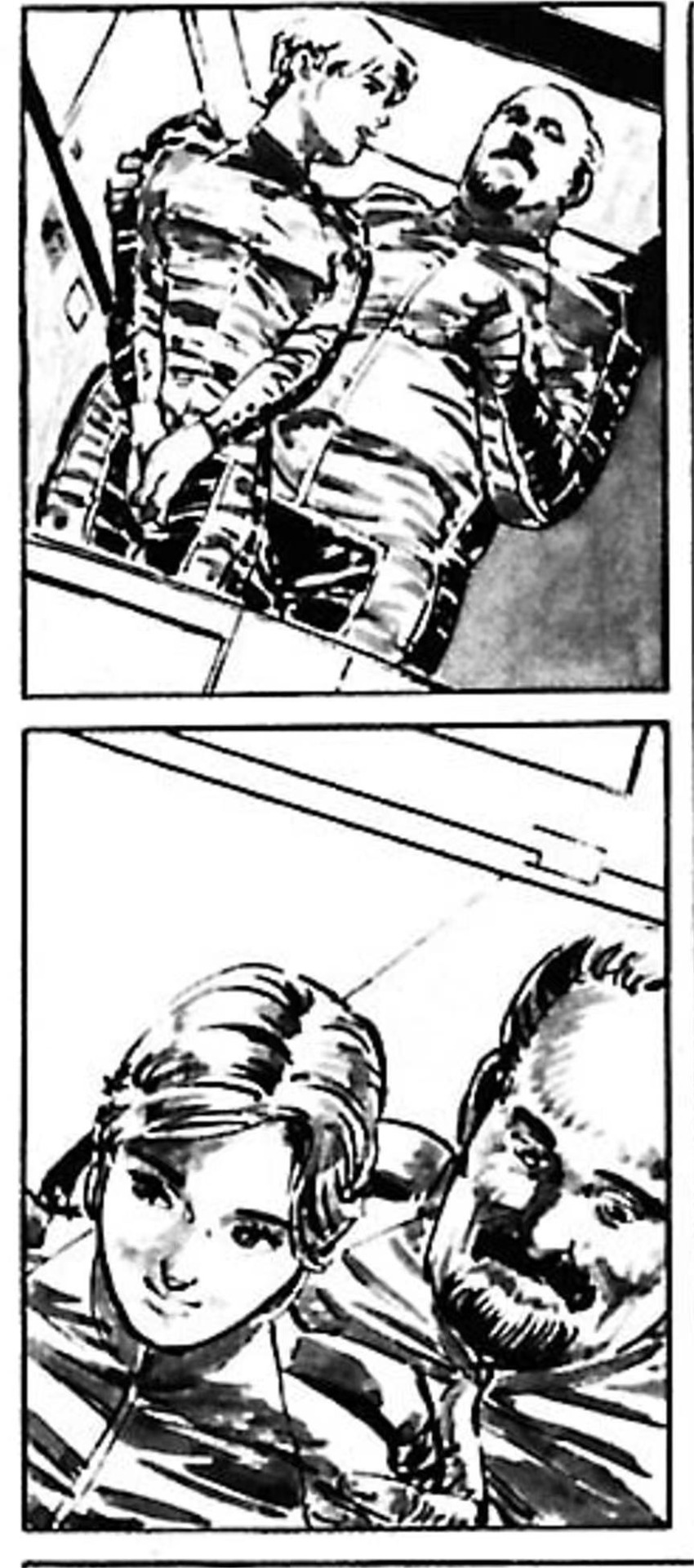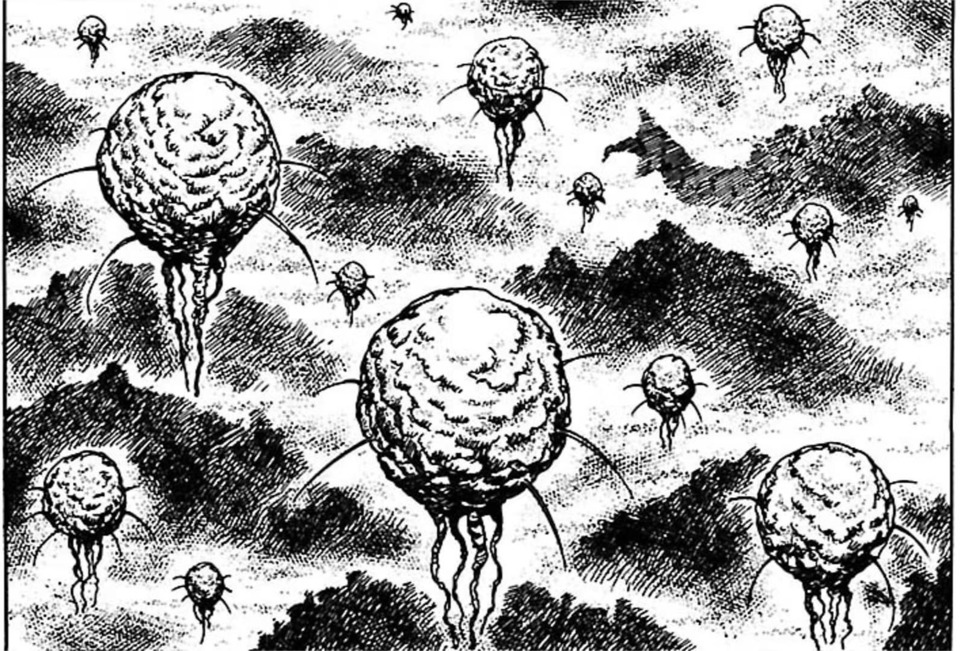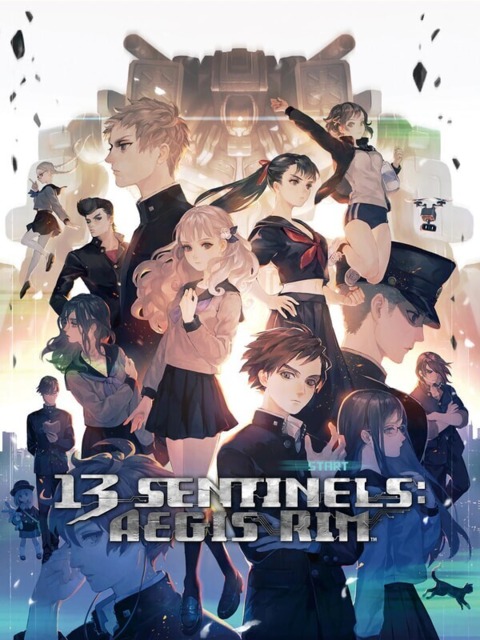
Waypoints in print
This is a Hideo Kojima adjacent book report since I would never have known this comic without reading an article by that snake oil salesman.

The book with yellow cover pictured above was translated into English as the Creative Gene, a collection of magazine column articles written by Hideo Kojima between 2007 and 2013. Most of those are book reports. Cover of the English edition says “How books, movies, and music inspired the creator of Death Stranding and Metal Gear Solid.” Or like Waypoint Radio hosts once said “to nerd out and deep dive into the culture, art and entertainment that inspire and provoke” the so-called video game auteur.
The one on 2001 Nights is more interesting by comparison. For one thing, it recounts both Kojima’s childhood encounter with Japanese comics and his early days at Konami. Since the article is dated to February, 2008, I am inclined to think that the death march to finish and ship Metal Gear Solid 4 Guns of Patriots made the man recalling his grunt days at the company. For another, there is the following passage:
2001 Nights has Asimov’s scientific pursuits, Clarke’s lyricism, Heinlein’s heroism, and even Bradbury’s fantasy.
I am actually calling Hideo Kojima a snake oil salesman out of respect, since he is not only good at selling “his own” products, but even better at selling things made by someone else. Calling a “funny book” the blend of all Big Three and Ray Bradbury is an instant sell for a reader of science fiction like yours truly. Though the book is hard to get hold of outside Japan. I didn’t read it until came out, sadly with the Kindle version on an Amazon Japan account. “Gob smacked” cannot even begin to describe my reaction.
Don’t call it a “funny book”
When the word “manga” is used in Japanese, it does come closer to “funny book”, for there is a counterpart called “gekiga” which is closer to “graphic novel”. Think how Emmy Awards separate scripted television into comedy and drama, and the difference between “manga” and “gekiga” shall be clear to you. The difference also comes down to art style. Manga is usually more cartoony, while gekiga is the photo realistic graphic of the 1970s before graphic became an essential aspect of video games. Between those 2, when the English phrase “comic book” was written out in katakana, it usually means the “larger than life” or “over the top” stuff.
On that regard 2001 Nights is a bona fide comic book laying towards gekiga. Its author, Yukinobu Hoshino is a stranger to me, mainly because of my bad habit: I almost exclusively read Japanese comics that have animated adaptions. Mr. Hoshino’s works have dense art style and denser scripts that just would keep most animation producers away.
Mr. Hoshino also loved to research the shit out for his works. Yamataika, a fantasy book that won him his first Seiun Sho Best Comic Award (the Japanese counterpart to Hugo Best Graphic Story), has a bibliosoph rivaling them non-fiction books. His work in the field of hard science fiction was not recognized by Seiun awards until the early teens. Inherit the Stars is a graphic novel based the first 3 Giant novels by James P Hogan.
I mention Inherit the Stars here partially because Kojima’s first book report in Creative Gene is about that book. Maybe it’s because Hogan got canceled for being a Holocaust denier, or maybe the Hogan estate is just stubborn, the English copy of those Giant novels were hard to come by when I heard about it in the late teens. With a in for a penny in for a pound mentality, I might as well read those much-more-beloved-by-Japanese-readers sci-fi novels in Hoshino’s comic form. The detailed and grand art sure made the ride worth it.
2001 Nights was years before those 2 books. The year when it was eligible for the Seiun, a Rumiko Takahashi classic titled Urusaiyatsura won the award. Guess a book about sad astronauts just could not beat a comedy featuring alien visitors at that time.
1980 nights short
The title 2001 Nights is obviously a mixture of 2 things. One being 1001 Nights or the Arabic Nights, a collection of bed time stories. Another being 2001 A Space Odyssey, the brain child of Stanley Kubrick and Arthur C Clarke. To put it bluntly, 2001 Nights is about the next 4 to 5 centuries where astronauts are sad for a variety of reasons.


Those are the English chapter titles I screen capture from the book’s Wikipedia page. Funny thing about this, there is one chapter before the First Night and another chapter after the Final Night, neither was translated into English. So, Hoshino made 21 nights out of 2001. At least that is a round number short.
The left untranslated first chapter is called Our Great Ancestors, and obviously a more violent retell of 2001 A Space Odyssey’s Dawn of Man segment. The first half focuses on how smaller primates had to keep running in the dangerous pre-historic Earth. The second half is about how the chimpanzee like human ancestors devasting everything in their way with a piece of bone, a full bloody page of different animals killed. The coda being chimpanzee in a space shuttle leading to none other than Major Gagarin of the USSR, the first man in space. Well, this story does give me the idea to type “monkey paw” a lot in this one.
The twenty first and final story Hoshino did in the 2001 Nights universe is titled In the Ocean of the Night. It’s more about First Contact and takes place about a century after the Final Night. Maybe it’s deemed not about sad astronauts enough, so the brand is “side story” and it’s not included in the 3 volumes of 2001 Nights. One has to purchase Hoshino’s looser anthology titled 2001+5 to read this one.
A gift keeps on giving to Kojima and company
Now onto what English speakers can read. I would not know too much about “scientific pursuits”, but structure wise 2001 Nights does mimic Isaac Asimov’s first three Foundation books and I, Robot. The Nights are rather loosely connected to each other. The discovery or advancement made in the previous chapter does impact the next, but do not except returning characters too often.
Earth Glow is a story very likely influenced the writing style of “A Hideo Kojima Game”. The plot is about a USA space shuttle delivering a payload to USSR space station L N Tolstoy. The Americans aboard think they are firing a nuke, but in fact it’s an arranged meeting between US president and USSR chairman. “Mr. President” bookend a conversation is a must-have there. The yank’s reaction to Tolstoy is “Truly War and Peace, heh?”, very tongue-in-cheek. One thing MGS3 evolved from previous was having references like that instead of just repeating.
Writers were not the only ones inspired by this book over at Kojima and company. There are two panel from A Stranger’s Footsteps. The story is a tragedy where a sentient planet unintentionally killed every human settler landing on them.

As you can see the space suits here are rather form fitting. Compared to those, the suits in previous stories usually has a Renaissance collar look to them. Also, I’m inclined to think that the sneaking suit protype in MGS3 is lifted wholesale from here. But, good “Hideo Kojima Game” is not the only ones to “steal” from this book, not good one did too. Here is a panel from Symbiotic Planet, the direct continuation of A Stranger’s Footsteps for people trying to avoid the fiasco in that story.

I got to admit that not-so-pleasant-to-look-at flying blubs like those are not exactly the most original of creature design, though seeing similar design during Death Stranding’s Washington DC still makes one think. The blubs in this comic are pacifiers while Death Stranding used similar design to break into Resident Evil territory. Very typical of video games.
Perhaps the biggest offender is how the relucent showdown between 2 sad commandoes plot in MGS3 was lifted from a story titled Colony. From jungle fighting to nuclear weapon in the hands of a single infantry unit, that story has it all.
Anti-matter, fossil fuel for the FTL age
The first several stories in 2001 Nights do just feel like 2001 A Space Odyssey homage:
Sea of Fertility is about a dig site on the Moon, though instead of an alien artifact they dug fossil of alien fishes.
Maelstrom III is about a miner in Asteroid Belt trying to escape after his facility hit by solar flare, the action is quite like how David trying to getting back into Discovery. Also the miner’s grandchild has a role to play in the last 2 stories of this book.
Posterity was cheekily subtitled Star Child in Japanese. I’m saving the content of this story for later into the article though.
Rendezvous also has the subtitle Star Gate in Japanese. The story is about cryo-sleep experiments overseen by old men like old David in the third act of 2001 A Space Odyssey. Also, a younger man into the cryo-sleep saw things we people wouldn’t believe.
Discovery is called Faraway Traveler in Japanese. The English title is referred to the deep space exploration vessel named Discovery. On board, an AI called KARC 9000, who would be called HAL by the men on the ship. KARC would meet a fate worse than death when they resurfaced in other stories of 2001 Nights.
Then there is Lucifer Rising, a 140 pages long epic marking 2001 Nights coming to its own. It’s a pivotal point for the book since human get fuel for faster-than-light on the fabled “tenth” planet (The story was written in the 1980s when Pluto still counted as planet.) of our solar system, Lucifer. Astronauts are sent there due to an accident when anti-matter caused explosion by simply touch matter. Among them a devoted catholic scientist Father Ramon handpicked by the Pope. The plot follows also includes a murderer mystery since the crew members are killed one by one.
The story has cosmic horror vibe since astronauts do see ancient creatures enclaved in the transparent chunks of anti-matter. But they might just be dead. This story is not about ancient evil waking up doing mind fucks, instead by accepting the too-ancient-to-be-recorded natural history of our solar system is more than enough for us furless monkeys to do mind fucks to ourselves. Coupled with the arts, the consistent quotes of Paradise Lost do not feel corny at all in this story. My words would not be sufficient enough to sell people on this story. You all should read it for yourself.
Keeping up with the Robinsons
Volume 2 of 2001 Nights opens with a pretty typical sad astronauts story titled the Lights of Heaven, where a Russian lady test pilot for the FTL engine would recall her brother’s death at his childhood. The one after this one titled Journey Beyond Tomorrow contains 2 stories actually.
The first story dealing with KARC and their worse-than-death faith. The AI was sent before human achieve FTL speed, so when people caught up them, the machine was simply ignored.
The second story dealing with the fictional Robinson Foundation’s effort in terraforming an alien planet. It looks simple on the surface, but its connection to an early story became an emotional thread of this whole book.
Posterity, or Star Child, deals with the pursued funder of Robinson Foundation and his wife donating both gene and meme for a space seed plan. Their genic material would be stored on a starship using a meteor for interstellar flight. Once the ship found a habitable planet, it would start making babies. The nanny bots on board would appear as Mr. and Mrs. Robinson to teach the kids everything they need to survive in the new world. Mrs. Robinson bot would ever shed tears for a kid died on the ship. The kids land on the planet called Ozmar III almost 4 centuries after departure. They think they are lucky and their new home was actually terraformed by a long died brother of theirs.
Without going to the details, I call tell you all that once out of that convoluted mystery box of its, 13 Sentinels: Aegis Rim tells the same exactly story. Though the raised by the Robinsons kids do not go to that good night just yet, they have one final test in Final Night: Children of the Earth or Songs of Distant Earth in Japanese. This book might as well go out with another Arthur C Clarke reference. Some of them chose to go with a space born human branch called New Generation for a voyage across the galaxy.
No one is welcomed
The thing about listening to Dan Carlin’s Hardcore History podcast, one would come to the conclusion that it’s not only the void outside our planet that does not want us there, the planet itself would keep us out with mountains, desert, steppe and oceans. All those terral at least have air for us to breathe.
The unmentioned until this point 2001 Nights stories all deal with the subject of how fucked up it is to be in space or on an alien planet:
Medusa’s Throne is a bit of play-it-for-farce take on the theme. Presented as a trilogy, truly ancient Greek tragedy play contest style, we got people crashed by rolling stone because they thought they saw a city. We got people swallowed by a tsunami made of sand instead of water. We got people cannot move because they would have been dead before stop in a total vacuum, they got burnt by a sun instead.
Final Evolution deals with 2001 Nights take on the perfect organism. But instead of that psychosexual piece H R Giger made for the 1979 cinematic classic, it looks like a black hole but does not act as people predict black holes would act.
Elliptical Orbit is a heartbreaker on many levels. A young and hot pirate queen style space trucker lady and an older man have to deal with a terror plot. By the end it is revealed that the man is actually the lady’s son, she just went into FTL trips a lot while his longer life became full of sorrow during her absence. This is not Robert A Heinlein’s time travel fuckery but it’s real close.
An Hour’s Song in a Birdless Sky and So Brief, so Lasting a Love both deals with human colony being destroyed on alien planets. The former due to sun fuckery yet a kind of local birds can time travel out of disaster. The latter due to local food source being toxic, but at least the leading lady there gets to rejoin her husband in a descent into an event horizon.
Odyssey in Green is a direct prequel to Final Night, where the dream of one Adam Robinson was crashed. He hoped to make First Contact with alien and only found some vegetable trying to escape their doomed planet. Space is too big to understand, yet contains so little for life.
Conclusion
Despite this being my longest book report to date, 2001 Nights is actually the briefest read of them all. I once thought that literature is the only good way to do the so-called hard science fiction, all after nothing can explain bullshit better than mere words. The book made me see the potential in comic since pretty pictures can success where dry words fail.
If all else fail, the stories about astronauts being sad here can give Hollywood’s endeavor in the genre as a whole a run for their money. Like the Abnormal Mapping duo said and I know how hard to take hold of them (I tried.), you all just got to read this.

Log in to comment